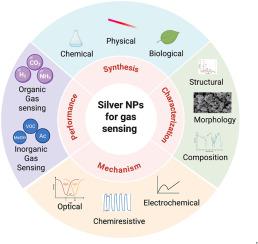Silver nanoparticles in gas sensing: A comprehensive review of synthesis, mechanisms, performance metrics, and emerging applications
IF 6.8
3区 材料科学
Q1 MATERIALS SCIENCE, MULTIDISCIPLINARY
Journal of Science: Advanced Materials and Devices
Pub Date : 2025-08-07
DOI:10.1016/j.jsamd.2025.100964
引用次数: 0
Abstract
Silver nanoparticles (AgNPs) possess unique physical, chemical, and antibacterial qualities, making them highly versatile and widely used in a variety of products. These nanoparticles are utilized across various fields, including electronics, biosensing, textiles, cosmetics, sunscreens, and medical devices. Due to their unique combination of high electrical conductivity, strong surface plasmon resonance (SPR), and efficient electron transfer properties, AgNPs have garnered significant attention for sensing applications. This review provides a comprehensive overview of AgNP-based gas sensors, covering synthesis methods and their influence on nanoparticle size, shape, and stability. The integration of AgNPs with supporting materials, such as metal oxides, reduced graphene oxide, and polymers, is also discussed, highlighting improvements in sensitivity, selectivity, and operational stability. Major sensing mechanisms are explained in relation to the detection of ammonia, hydrogen sulfide, ethylene, and other relevant gases. These insights aim to guide the development of advanced AgNP-based gas sensors with enhanced performance for environmental and biomedical applications.

银纳米粒子在气体传感:综合审查的合成,机制,性能指标,和新兴的应用
银纳米粒子(AgNPs)具有独特的物理、化学和抗菌特性,使其具有高度的通用性,并广泛应用于各种产品中。这些纳米粒子被用于各种领域,包括电子、生物传感、纺织品、化妆品、防晒霜和医疗设备。由于其独特的高导电性、强表面等离子体共振(SPR)和高效的电子转移特性,AgNPs在传感应用中获得了极大的关注。本文综述了基于agnp的气体传感器,包括合成方法及其对纳米颗粒大小、形状和稳定性的影响。还讨论了AgNPs与支撑材料(如金属氧化物、还原氧化石墨烯和聚合物)的集成,强调了灵敏度、选择性和操作稳定性的改进。主要的传感机制解释了有关检测氨,硫化氢,乙烯和其他相关气体。这些见解旨在指导先进的基于agnp的气体传感器的开发,这些传感器具有增强的环境和生物医学应用性能。
本文章由计算机程序翻译,如有差异,请以英文原文为准。
求助全文
约1分钟内获得全文
求助全文
来源期刊

Journal of Science: Advanced Materials and Devices
Materials Science-Electronic, Optical and Magnetic Materials
CiteScore
11.90
自引率
2.50%
发文量
88
审稿时长
47 days
期刊介绍:
In 1985, the Journal of Science was founded as a platform for publishing national and international research papers across various disciplines, including natural sciences, technology, social sciences, and humanities. Over the years, the journal has experienced remarkable growth in terms of quality, size, and scope. Today, it encompasses a diverse range of publications dedicated to academic research.
Considering the rapid expansion of materials science, we are pleased to introduce the Journal of Science: Advanced Materials and Devices. This new addition to our journal series offers researchers an exciting opportunity to publish their work on all aspects of materials science and technology within the esteemed Journal of Science.
With this development, we aim to revolutionize the way research in materials science is expressed and organized, further strengthening our commitment to promoting outstanding research across various scientific and technological fields.
 求助内容:
求助内容: 应助结果提醒方式:
应助结果提醒方式:


